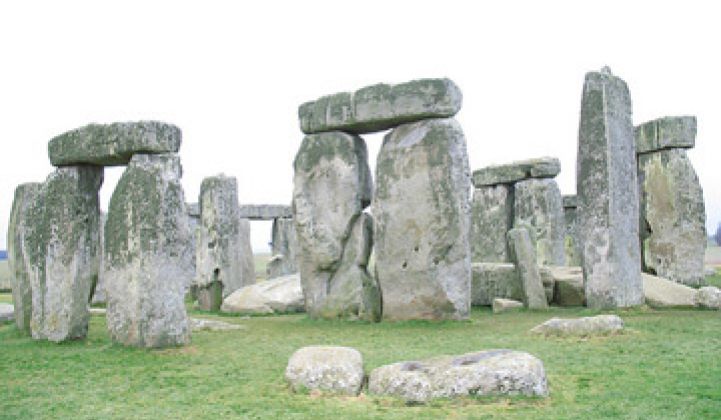EscoVale Consultancy Services has come up with a new technology that Archimedes, Barney Rubble or your average Druid engineer would recognize.
The company, based in England, is proposing a sort of upside-down version of pumped hydro storage using a 100 million ton rock. In classic pumped hydro storage, water from an upper reservoir is released to fall into a lower reservoir. On the way down, it flows through a turbine and creates energy.
In EscoVale's Logan Stone proposal, a mountain-sized boulder would sit inside a tight-fitting reservoir. Water would be pumped beneath the stone to make it float upward. When power is needed, a valve is opened. Pressured by the boulder, water gushes through the turbine.
The Logan Stone wouldn’t be brought to the reservoir. It would be quarried in place. A hole in the center of the stone would be drilled to fit in equipment to cut the bottom of the stone from the surface of the reservoir. (A Logan stone is a finely cut rock.) It would then be sealed; otherwise, you’d get a geyser.
“A major pumped hydro storage project might be rated at 2GW, storing 20GWh by pumping 10MT of water 750m uphill over a period of 10 hours. In the absence of a suitable mountain, we could get the same result by pumping 150MT of water up a 50m hill. That is not practical because of the huge size and cost of the reservoirs. We would not need reservoirs if we were to raise a 150MT concrete disc by 50m. Unfortunately, that would be too expensive, even if we could work out how to lift it!
“However, since we are sitting on lots of convenient rock, we might be able to make a disc quite cheaply by removing a tiny amount of material from around a disc shape. In this case, “tiny” still equates to millions of tonnes, but that is not a show-stopper -- the world’s extractive industries dig up more than 100MT every day,” reads a paper from the firm.
In this scenario, moving the disc 50 meters would release the equivalent of 20 gigawatt-hours of energy over a 10-hour period.
It could be built on land or underwater near the seashore, depending on the material of your stone. Gravity Power is working on a similar idea. Conversely, Vycon has a big massive flywheel that turns the force behind a falling 30-ton shipping crate into regenerative power for a crane. So maybe it's a new category: Jurassic storage.
“If the target pressure is 75bar, the disc would be about 500m high and 500m diameter. A pressure of 45bar would require a disc about 300m high and 650m diameter,” the report states.
The concept faces some practical hurdles. Can you find the appropriate type of rock? How much does it cost to quarry? Still, 300 meters by 650 meters is not a huge mining project. And it is easier to achieve large-scale storage with geological storage like pumped hydro or compressed air than with lithium-ion batteries. Currently, compressed air remains the cheapest form of storage available.



